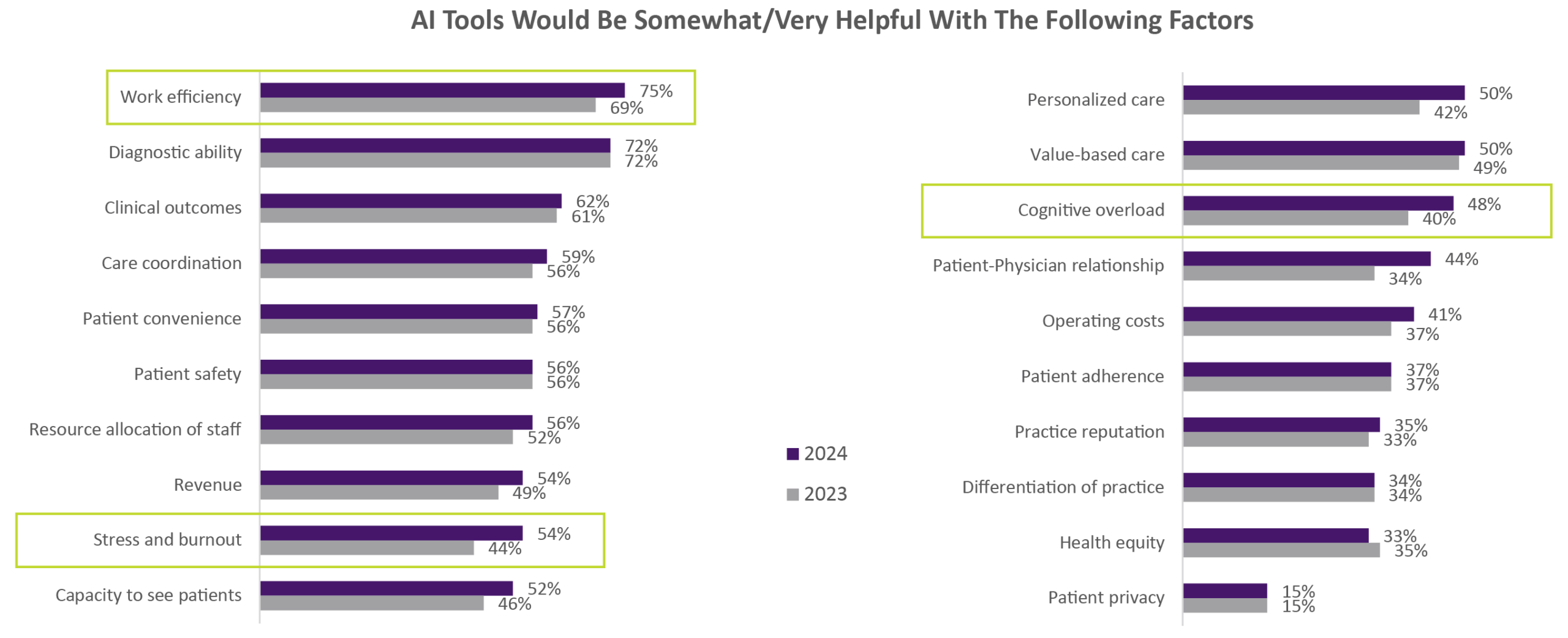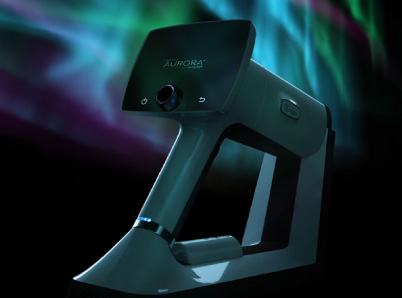A growing majority of physicians recognize AI’s benefits and see how it can provide advantages for patient care. An AMA poll published in 2025 found that about 5% more physicians noted its benefits and showed increased enthusiasm for its use in healthcare than the previous year. As AI is adopted more widely by the healthcare community, we have seen success stories and improvements in physician happiness.
In a 2025 Harris Poll physician survey, there was a 5% decrease in physician burnout and 8% fewer physicians considering leaving the profession. In this same survey, 68% of physicians surveyed said that in the past year, they looked forward to coming to work each day at least once a week or more. This coincided with the rise in artificial intelligence in healthcare over the past 12 months, changing how healthcare is delivered. Researchers note burnout is complex and can stem from frustrations with pay, difficult patients, volume and intensity of work, and advancement opportunities. While multiple factors might be driving the changes in sentiment, the results from this year’s physician satisfaction survey indicate that improvements in technology, especially the use of AI to address administrative burdens, are a main driver.
Of those physicians using AI in their practice, 68% noted increased use of AI to help generate clinical documentation. They also view the biggest potential benefits as helping improve clinical documentation (48%) and helping reduce the administrative burden (46%). Physicians also reported spending more time with patients relative to 2023, which could partially explain the shift in burnout and quit intentions, according to the survey. 51% percent of physicians reported having adequate time with patients, up from 43% in 2023. While 35% of respondents said patient volumes and costs negatively impact their ability to provide quality care at least once a week, that’s down from the 50% of respondents who said volumes and costs impacted care at least once a week in 2023.
Physician Sentiment is Positive
A growing majority of physicians recognize AI’s benefits and see how it can provide an advantage for patient care.
A 2024 AMA poll of physicians found that 68% of respondents could recognize AI’s benefits in patient care, which was up from 63% from 2023’s poll. 28% of physicians said that using AI has a ‘definite advantage’ for patient care. Similarly, in 2024 36% of physicians reported feeling more excited than concerned about AI use in healthcare, up from 30% in 2023.
They report that a reporting feedback loop, data privacy assurances, workflow integration, and robust training and education are critical factors for even greater AI adoption. Nearly half ranked increased regulatory oversight as the number one action needed to increase trust in AI tools.
This poll also showed a doubling of AI users to nearly 66%, with a third of those polled stating that they use clinical AI-enabled tools in their practice. Physicians were able to name many factors where AI tools could be helpful in making their jobs easier and improving patient satisfaction.
Importance of Interoperability in Healthcare
Interoperability is the cornerstone for effective AI integration in clinical practice. In this same Harris survey of over 1,000 physicians, 95% of physicians said getting the right clinical data at the right time is very important to them. 72% say that improved connectivity between information systems is most critical to simplifying the practice of care. Interoperability is essential throughout the Data Life Cycle, creating seamless information exchange that powers timely and effective healthcare. Implementing interoperable systems reduces administrative burden on clinicians, optimizes data processing, facilitates algorithm sharing for validation, and enhances the clinical significance of AI-derived insights. Its successful execution is crucial for realizing AI’s full potential in healthcare, ultimately improving clinical outcomes and care quality.
Getting information right when you need it makes decision making easier, and quicker. In managing patients with diabetes, the Primary Care physician is responsible for the patient getting an eye examination through an eye care specialist. This is reflected in the Comprehensive Diabetes Care HEDIS measure outline. Scores can be challenging due to barriers such as access to eye care specialists, patient compliance in going to the eye care appointment once referred, and documentation issues in receiving the eye care specialist report and reconciling the associated CPT II code. However, the advent of AI-powered DR screening platforms offers an innovative solution to overcome these hurdles and improve HEDIS performance. Cameras like the FDA cleared Aurora AEYE can quickly and easily take an image of the patient’s retina, send to AI for analysis, and return a result in less than a minute. Now you’re able to close the care gap while the patient is in the office and get credit for the performance measure. Having that information while the patient is in your office allows for better management of their disease state, better communication to the patient, and higher quality referrals to eye care specialists. You’re now able to monitor patients who show no signs of referable disease and pass along those who could use treatment to the ophthalmologist at an earlier stage for vision saving intervention.
Using AI to Improve Patient Care
Doctors enjoy taking care of patients and doing their jobs when technology is not in their way. They mention that AI tools would be very helpful for work efficiency, diagnostic ability, cognitive overload, care coordination, and patient convenience. Things like the Aurora AEYE DR screening platform can help ease the burden on both the physician and patient for completing the eye examination portion of their comprehensive diabetes care. Only about half of physicians are familiar with AI use cases for assistive diagnosis, but many expect to incorporate their use within the next year.
Optomed’s Aurora AEYE provides an opportunity for early diagnosis, treatment, and vision loss prevention. The only handheld non-mydriatic fundus camera with integrated AI screening for DR. The FDA clearance trials demonstrated best-in-class efficacy and imageability. Diagnostic sensitivity was in the range of 92%-93% and specificity was in the range of 89%-94%. In both studies, over 99% of patients received a diagnostic result. The AI produced its diagnostic results and care plan using only a single image from each eye, rarely requiring dilation. Its HIPAA compliant and cybersecure workflow integrates into your EMR. Improve HEDIS and Star ratings, patient satisfaction, and outcomes by implementing the Aurora AEYE DR screening system in your clinic today.

